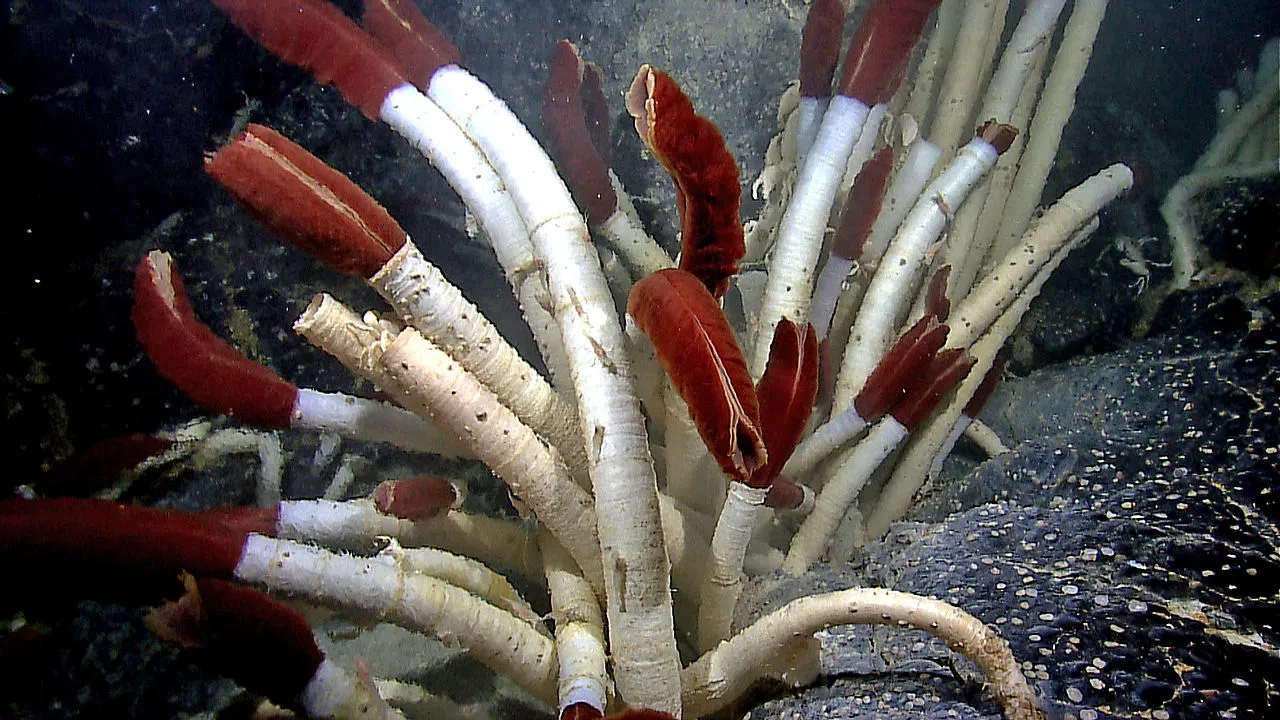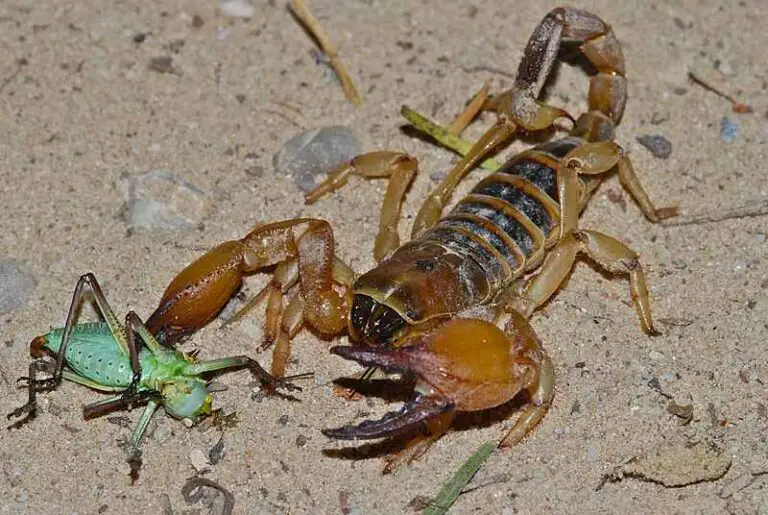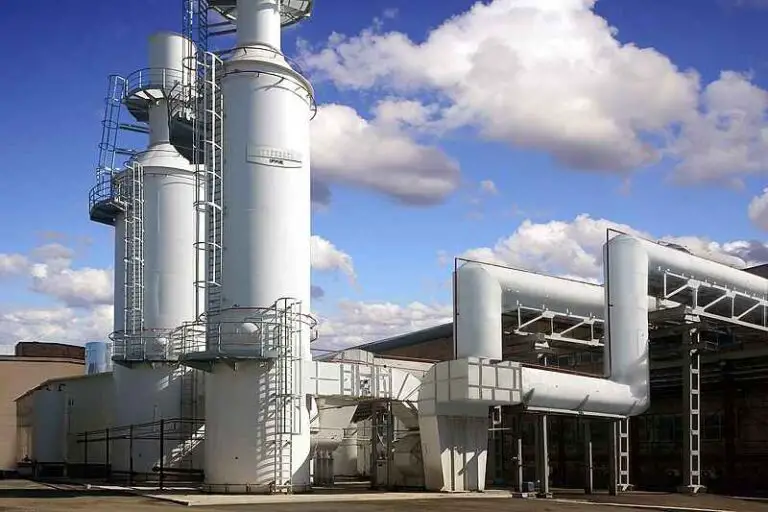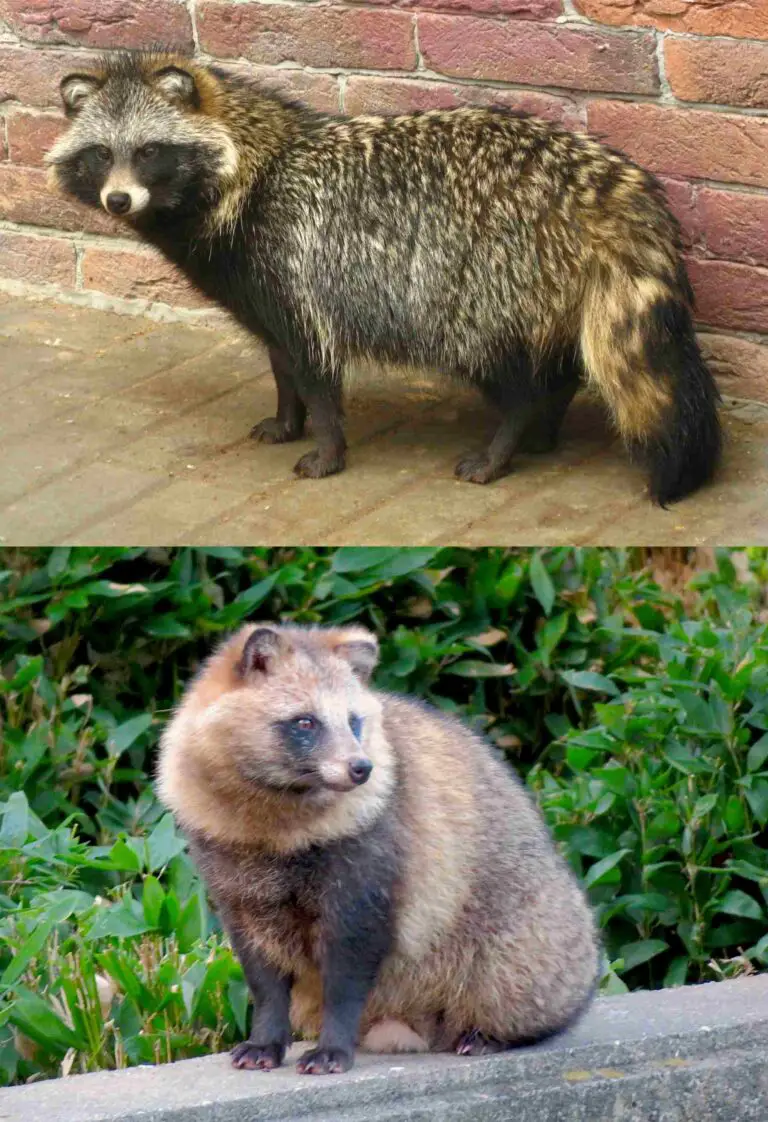What Do Tube Worms Eat? Tube Worm Food Chain Position/Role
Tube worms, specifically those found in deep-sea hydrothermal vent environments, do not consume food in the traditional sense. Instead, they rely on a remarkable symbiotic relationship with chemosynthetic bacteria living within their bodies. These bacteria convert chemicals such as hydrogen sulfide and methane, which are abundant in the vent environment, into organic molecules through a process called chemosynthesis. The tube worms then absorb these organic compounds produced by the bacteria as their primary source of nutrition. This unique feeding mechanism allows tube worms to thrive in extreme deep-sea conditions where traditional forms of photosynthesis are not possible.
How Do Tube Worms Eat?
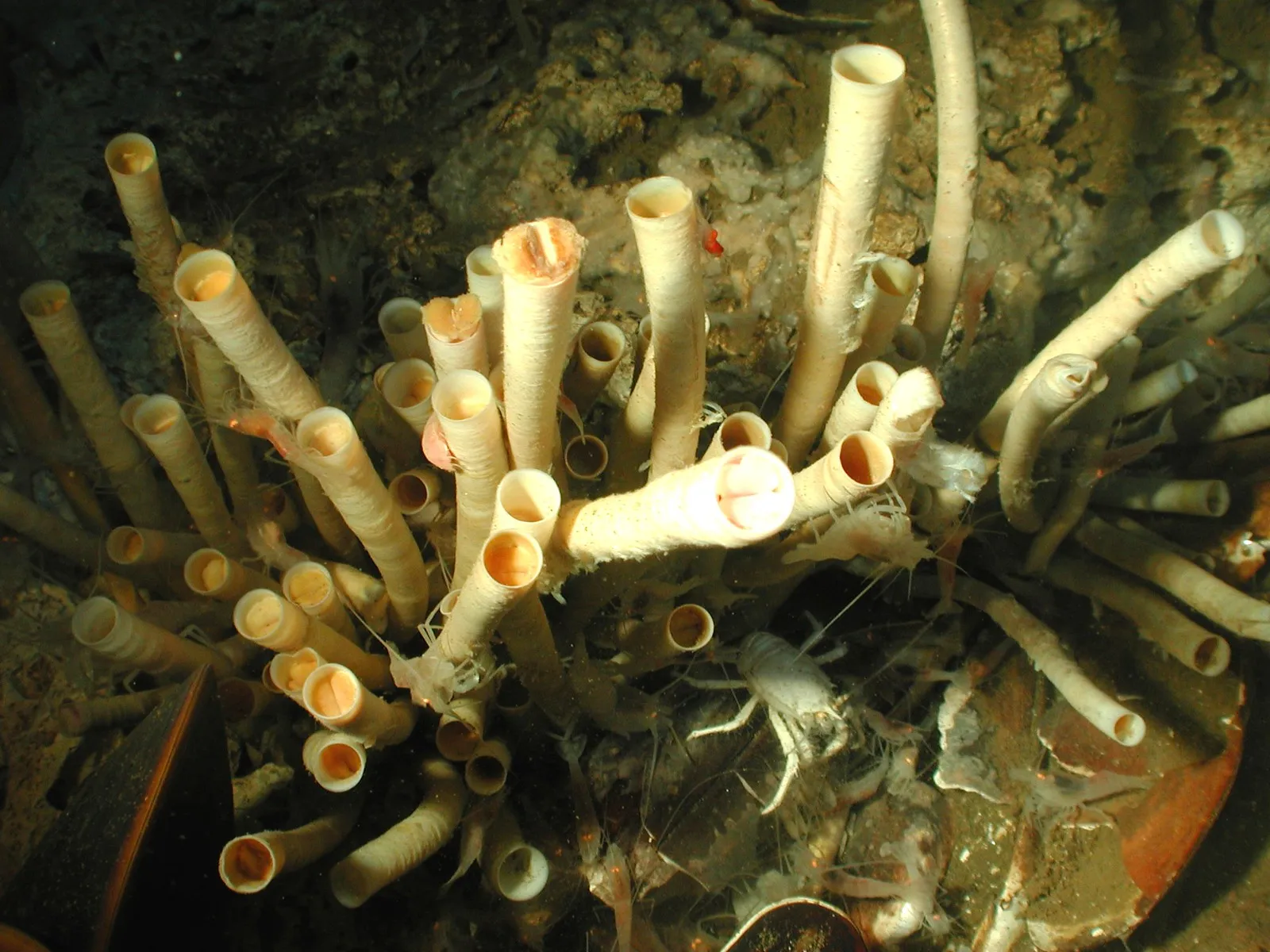
Tube worms have evolved a fascinating strategy for obtaining nutrition in their deep-sea habitats. Rather than actively feeding on organic matter, they have formed a symbiotic relationship with chemosynthetic bacteria. These bacteria reside within specialized organs called trophosomes, located in the tube worm’s body. Through chemosynthesis, the bacteria utilize inorganic compounds such as hydrogen sulfide and methane, which are abundant in their vent environments, to produce organic molecules. The tube worms then absorb these organic compounds directly from the bacteria, effectively “feeding” off the products of their symbiotic partners. This unique feeding process allows tube worms to thrive in the absence of sunlight and conventional food sources, making them highly adapted to their extreme deep-sea habitats.
Steps in the Symbiotic Nutrition Process of Tube Worms
The symbiotic nutrition process of tube worms involves several intricate steps that allow them to thrive in their deep-sea hydrothermal vent habitats:
-
Chemical Absorption: Tube worms inhabit environments rich in hydrogen sulfide and methane, which are released from hydrothermal vents. These chemicals serve as the primary energy source for the symbiotic bacteria living within the tube worm’s trophosome.
-
Chemosynthesis: Within the trophosome, the chemosynthetic bacteria convert the inorganic compounds into organic molecules through a process known as chemosynthesis. This process is analogous to photosynthesis but does not rely on sunlight.
-
Organic Absorption: The tube worm absorbs the organic molecules produced by the symbiotic bacteria directly from the trophosome. These organic compounds serve as the primary source of nutrition for the tube worm.
-
Metabolic Utilization: Once absorbed, the organic molecules are metabolized by the tube worm to provide energy for various physiological processes, including growth and reproduction.
By relying on this symbiotic relationship with chemosynthetic bacteria, tube worms have adapted to thrive in the extreme conditions of deep-sea hydrothermal vents, where traditional food sources are scarce.
How Do Tube Worms Survive?
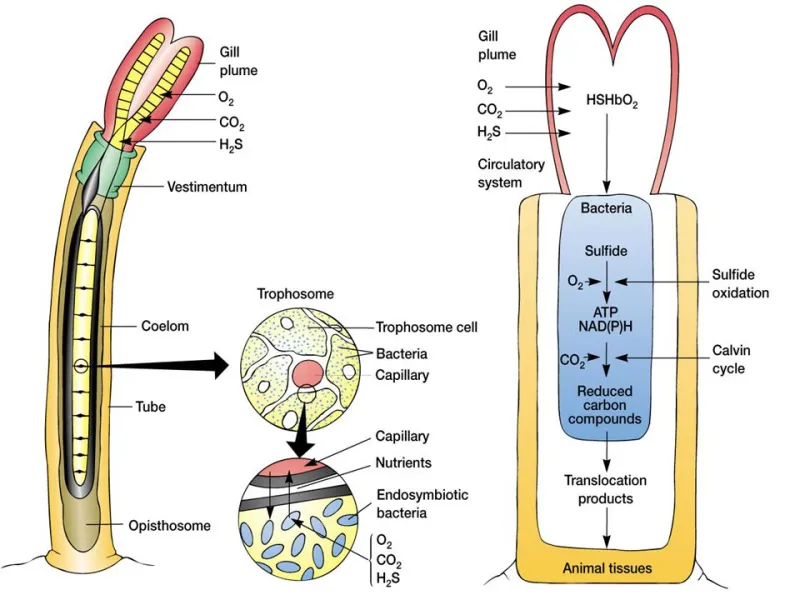
Tube worms have evolved remarkable adaptations that enable their survival in the harsh conditions of deep-sea hydrothermal vent environments:
-
Symbiotic Relationship: Tube worms have formed a symbiotic relationship with chemosynthetic bacteria, which provide them with essential nutrients through chemosynthesis. This allows tube worms to thrive in environments devoid of sunlight and traditional food sources.
-
Heat Tolerance: Hydrothermal vents emit scalding-hot water, yet tube worms are able to withstand temperatures exceeding 90°C (194°F) due to specialized proteins and enzymes that protect their tissues from thermal damage.
-
Pressure Adaptation: Deep-sea environments exert immense pressure, but tube worms possess adaptations such as reinforced body structures and flexible tissues that enable them to withstand the extreme pressures found at depths of thousands of meters.
-
Resilience to Toxic Compounds: Hydrothermal vents release high concentrations of toxic chemicals such as hydrogen sulfide, yet tube worms have evolved mechanisms to detoxify these compounds or tolerate their presence without harm.
-
Reproductive Strategies: Tube worms employ various reproductive strategies, including broadcast spawning and brooding, to ensure the survival of their offspring in unpredictable deep-sea environments.
By leveraging these adaptations, tube worms have successfully colonized deep-sea hydrothermal vent ecosystems and thrive despite the challenging conditions they face.
What Do Tube Worms Need To Survive?
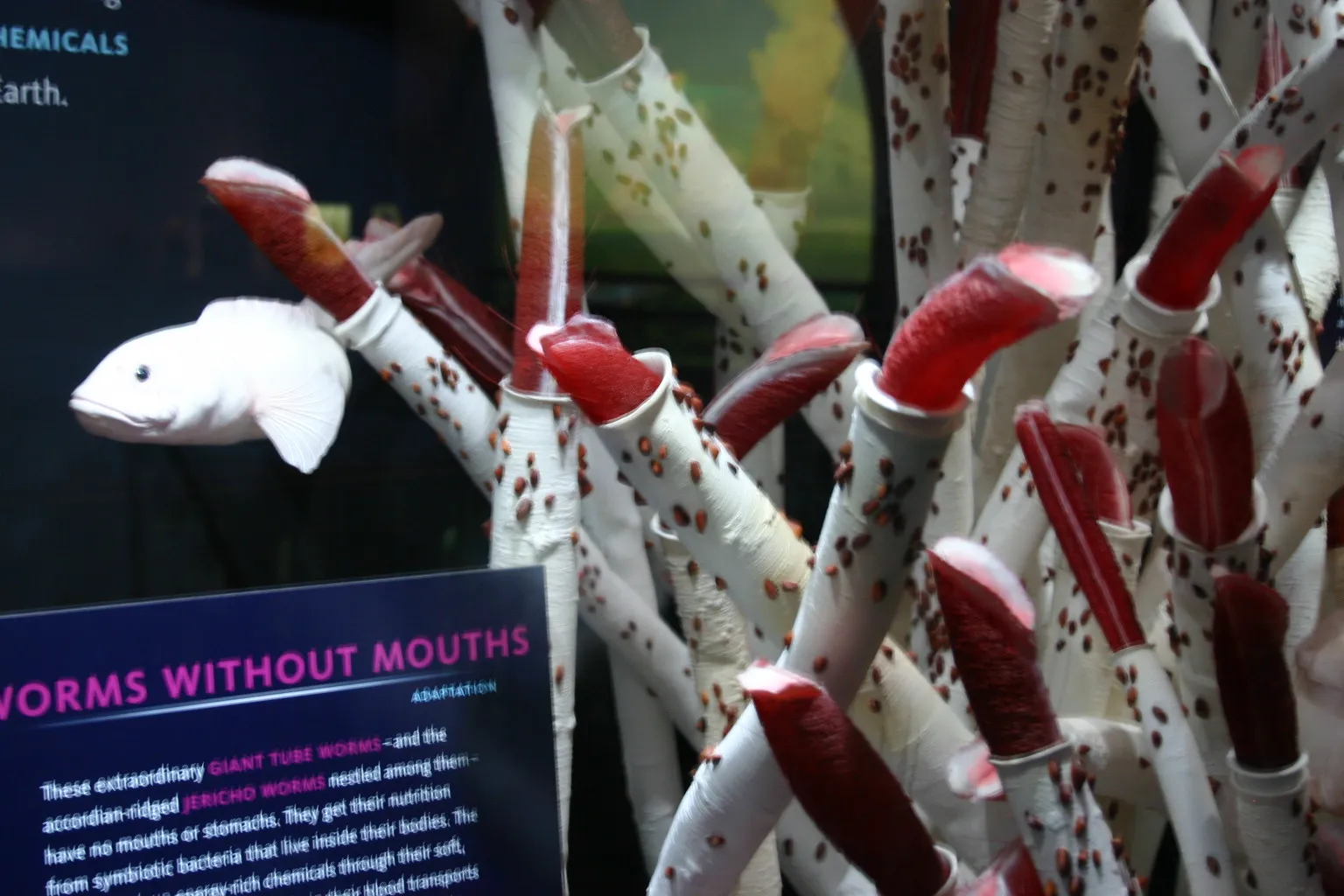
Tube worms have specific requirements for survival in their deep-sea hydrothermal vent habitats:
-
Symbiotic Bacteria: Tube worms depend on symbiotic relationships with chemosynthetic bacteria. These bacteria convert inorganic compounds into organic molecules through chemosynthesis, providing essential nutrients for the tube worms’ survival.
-
Hydrothermal Vent Environment: Tube worms inhabit deep-sea hydrothermal vent environments characterized by high temperatures, extreme pressures, and abundant chemical compounds such as hydrogen sulfide and methane. They rely on these conditions for their symbiotic bacteria to thrive and produce nutrients.
-
Protection from Heat and Pressure: Tube worms have adaptations to withstand the high temperatures and pressures found near hydrothermal vents. Specialized proteins and enzymes protect their tissues from thermal damage, while reinforced body structures and flexible tissues help them endure the extreme pressures of the deep sea.
-
Access to Oxygen: Despite living in environments devoid of sunlight, tube worms still require oxygen for respiration. They likely obtain oxygen from the surrounding seawater or through specialized structures within their bodies.
-
Reproductive Opportunities: Tube worms need opportunities to reproduce and propagate their species. They employ various reproductive strategies adapted to the unique challenges of deep-sea environments, ensuring the survival of their offspring.
By meeting these essential needs, tube worms can thrive in the extreme conditions of deep-sea hydrothermal vents and sustain their populations over time.
What Do Giant Tube Worms Eat?
Giant tube worms, like other tube worms found in deep-sea hydrothermal vent environments, do not directly consume food in the traditional sense. Instead, they rely on a symbiotic relationship with chemosynthetic bacteria. These bacteria live within specialized organs called trophosomes inside the tube worms’ bodies. Through chemosynthesis, the bacteria convert inorganic compounds, such as hydrogen sulfide and methane, into organic molecules that the tube worms can absorb as their primary source of nutrition. This unique feeding strategy allows giant tube worms to thrive in the extreme conditions of the deep sea, where conventional forms of photosynthesis are not possible.
Where Do Giant Tube Worms Live?
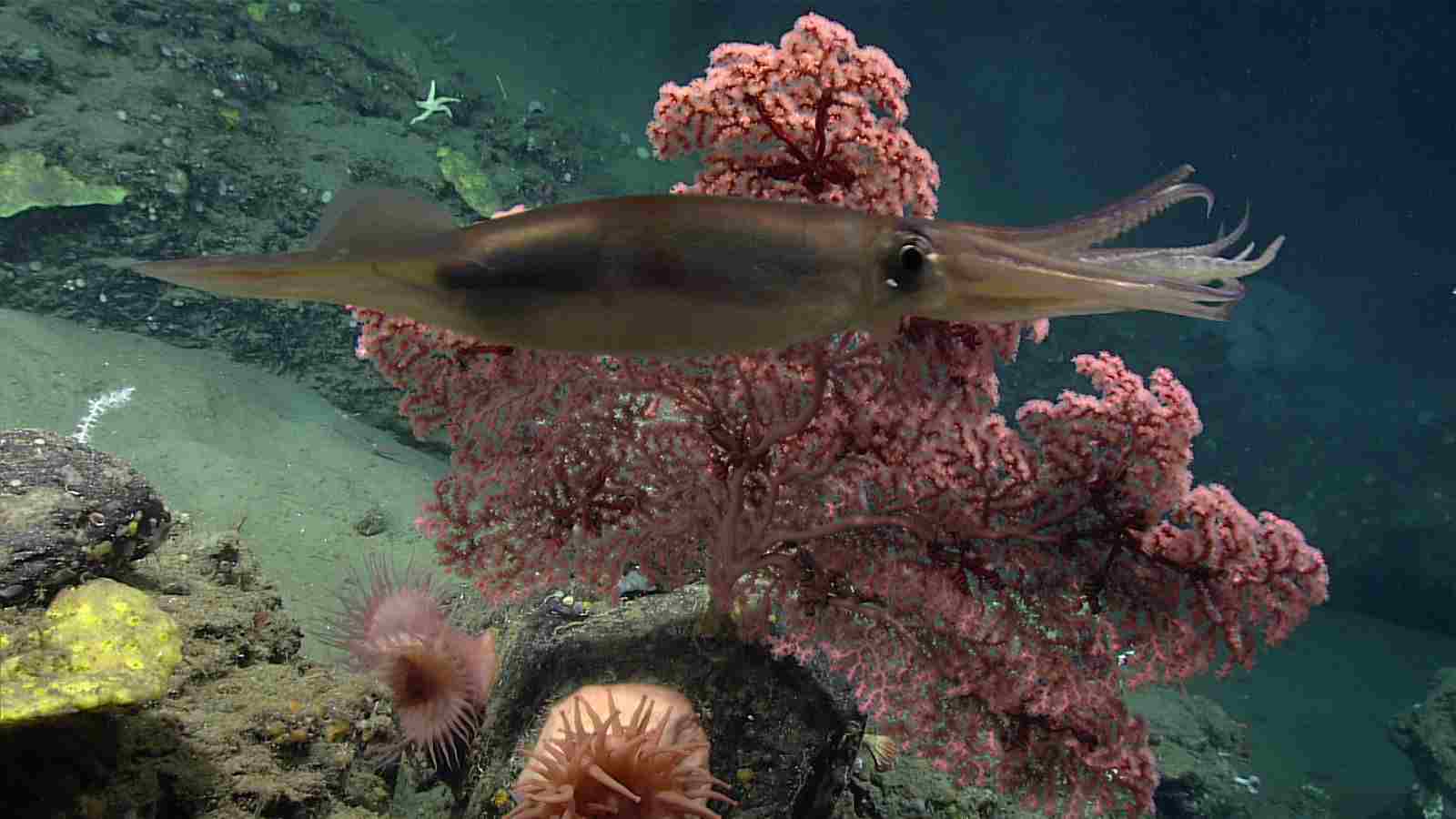
Giant tube worms are typically found in deep-sea hydrothermal vent environments, which are located along mid-ocean ridges and other tectonically active areas of the ocean floor. These hydrothermal vents emit superheated water rich in minerals and chemicals, creating unique ecosystems in the deep sea. Giant tube worms specifically inhabit the vicinity of these vents, often clustering around openings where hot fluids are discharged into the surrounding seawater. These environments are characterized by extreme conditions, including high temperatures, intense pressures, and toxic chemical compounds. Despite these challenges, giant tube worms have adapted to thrive in these harsh deep-sea habitats, forming integral parts of complex vent ecosystems.
Giant Tube Worm Adaptations for Survival
Giant tube worms have evolved numerous adaptations to survive in the extreme conditions of deep-sea hydrothermal vent environments:
-
Symbiotic Relationship: Like other tube worms, giant tube worms have formed symbiotic partnerships with chemosynthetic bacteria. These bacteria reside within specialized organs called trophosomes and provide essential nutrients to the tube worms through chemosynthesis.
-
Heat Tolerance: Giant tube worms can withstand temperatures exceeding 90°C (194°F) near hydrothermal vents. They possess specialized proteins and enzymes that protect their tissues from thermal damage caused by the scalding-hot vent fluids.
-
Pressure Resistance: Deep-sea environments exert immense pressure, but giant tube worms have adapted to this by having reinforced body structures and flexible tissues that allow them to withstand the extreme pressures found at depths of thousands of meters.
-
Resilience to Toxic Chemicals: Hydrothermal vents release high concentrations of toxic compounds such as hydrogen sulfide. Giant tube worms have evolved mechanisms to either detoxify these chemicals or tolerate their presence without harm.
-
Efficient Nutrient Absorption: Giant tube worms have evolved specialized structures, such as highly vascularized plumes, to efficiently absorb nutrients produced by their symbiotic bacteria.
-
Reproductive Strategies: Giant tube worms employ various reproductive strategies to ensure the survival of their species in unpredictable deep-sea environments, including broadcast spawning and brooding.
Through these adaptations, giant tube worms have successfully colonized and thrived in the challenging conditions of deep-sea hydrothermal vents, playing crucial roles in the ecosystems of these unique environments.
What Feeds On Tube Worms?
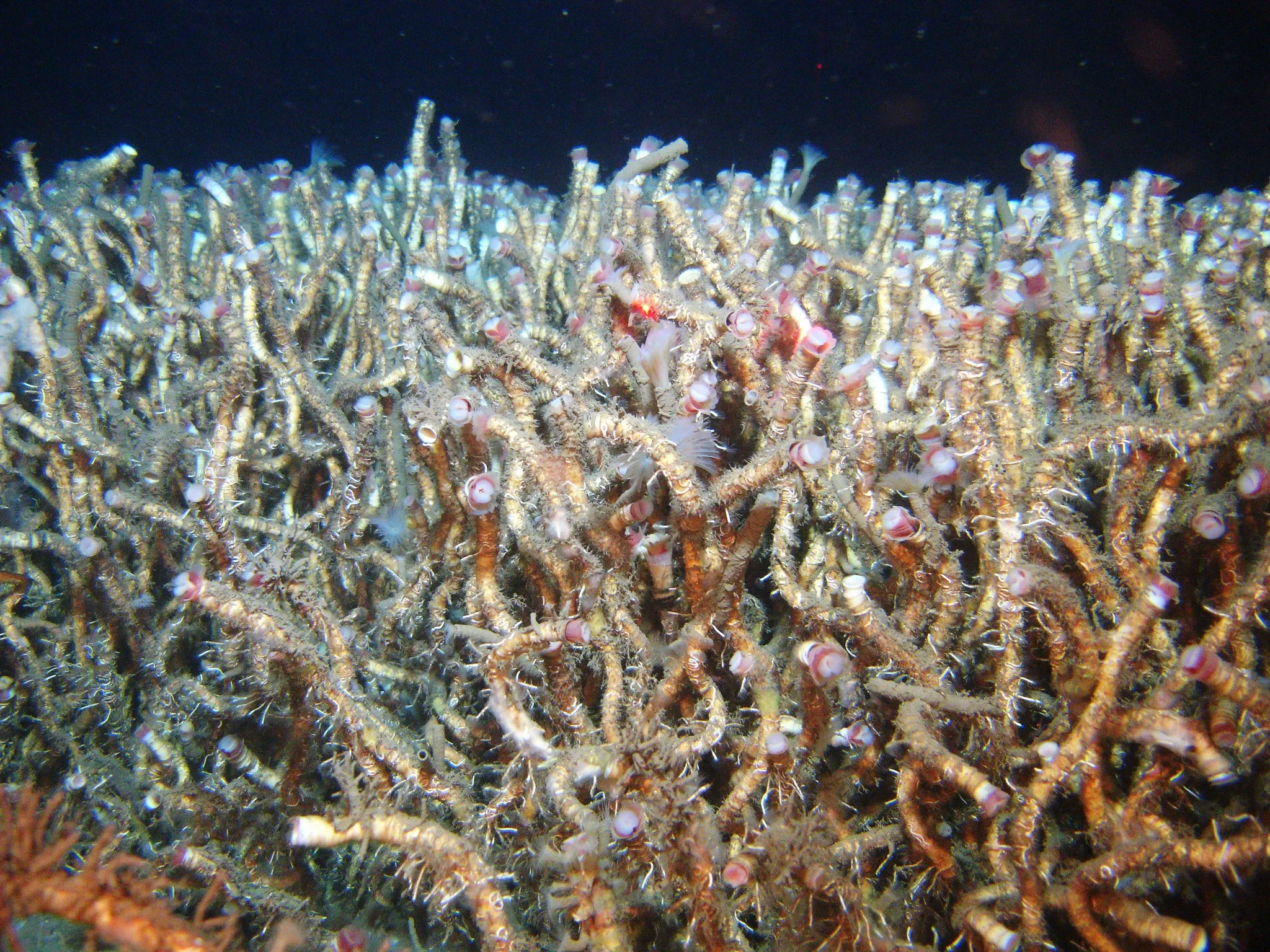
While tube worms have few natural predators due to their extreme environment and specialized adaptations, there are still some organisms that feed on them. Some of the primary predators of tube worms include:
-
Predatory Marine Invertebrates: Certain species of marine invertebrates, such as predatory snails, crabs, and shrimp, may feed on tube worms. These organisms may consume tube worms either directly or by attacking their soft tissues.
-
Fish and Other Vertebrates: Some deep-sea fish species and other vertebrates that inhabit hydrothermal vent ecosystems may prey on tube worms. These predators may include fish species adapted to the high-pressure and high-temperature conditions of the deep sea.
-
Microbial Predators: Microorganisms, such as certain bacteria and protists, may also prey on tube worms by consuming their tissues or competing with their symbiotic bacteria for resources.
While tube worms have evolved defenses against predation, such as their heat tolerance and chemical deterrents, they are still vulnerable to predation from specialized organisms adapted to their deep-sea habitat.
How Quickly Do Tube Worms Grow?
Tube worms exhibit varying rates of growth depending on factors such as environmental conditions, food availability, and species-specific traits. In general, tube worms found in deep-sea hydrothermal vent environments can grow relatively quickly compared to their shallow-water counterparts due to the abundance of nutrients provided by their symbiotic bacteria.
However, specific growth rates can vary widely among different species of tube worms. Some studies have suggested that certain species of tube worms in hydrothermal vent ecosystems can grow several centimeters per year under optimal conditions. Factors such as temperature, chemical composition of the vent fluids, and the efficiency of symbiotic nutrient exchange can all influence the growth rates of tube worms.
It’s important to note that because tube worms live in extreme deep-sea environments that are challenging to access, studying their growth rates in detail can be difficult, and much of the data available comes from observations in controlled laboratory settings or from indirect measurements in the field.
Factors that Influence the Growth of Tube Worms
Several factors play crucial roles in influencing the growth rates of tube worms in deep-sea hydrothermal vent environments:
-
Nutrient Availability: The availability of nutrients, primarily derived from the chemosynthetic activities of symbiotic bacteria, is a key determinant of tube worm growth. Higher concentrations of nutrients, such as hydrogen sulfide and methane, in the vent fluids can support increased growth rates.
-
Temperature: Tube worms inhabit environments with elevated temperatures near hydrothermal vents. Optimal temperatures within a certain range can promote metabolic activity and growth, while extreme temperatures may inhibit growth or cause tissue damage.
-
Vent Fluid Composition: The chemical composition of hydrothermal vent fluids, including concentrations of hydrogen sulfide, methane, and other compounds, can vary between different vent sites. Tube worms may exhibit preferences for specific vent fluid compositions that enhance their growth.
-
Competition and Predation: Competition for resources and predation pressure from other vent organisms can impact tube worm growth rates. In environments with high competition or predation risk, tube worms may allocate more resources to defense mechanisms rather than growth.
-
Reproductive Effort: Tube worms allocate energy resources to reproduction, which can influence their growth rates. Individuals investing heavily in reproduction may exhibit slower growth compared to those prioritizing growth and maintenance.
-
Genetic and Species-Specific Traits: Different species of tube worms may have inherent genetic differences and physiological traits that affect their growth rates. Some species may be adapted to grow more rapidly under specific environmental conditions.
Understanding how these factors interact and influence tube worm growth is crucial for comprehensively studying their ecology and population dynamics in deep-sea hydrothermal vent ecosystems.
Are Tube Worms Dangerous?
Tube worms themselves are not considered dangerous to humans. They are passive filter feeders or rely on symbiotic bacteria for nutrition and do not possess any means of actively harming humans. In fact, they play important ecological roles in deep-sea ecosystems, contributing to nutrient cycling and providing habitat for other organisms.
However, the extreme environments where tube worms are found, such as deep-sea hydrothermal vents, can pose significant challenges and risks to human exploration. Vent environments are characterized by high temperatures, intense pressures, and toxic chemicals, which can be hazardous to equipment and personnel. Additionally, the deep-sea exploration necessary to study tube worms and their habitats involves technical challenges and risks associated with deep diving and remote operations.
Overall, while tube worms themselves are not dangerous, the environments they inhabit present unique challenges that require careful consideration and specialized equipment for safe exploration and research.
How Do Giant Tube Worms Reproduce?
Giant tube worms employ various reproductive strategies adapted to their deep-sea hydrothermal vent environments:
-
Broadcast Spawning: Some giant tube worm species release eggs and sperm into the water column simultaneously during spawning events. This broadcast spawning allows for the dispersal of gametes over long distances, increasing the chances of fertilization and genetic diversity among offspring.
-
Brooding: Other giant tube worm species may retain fertilized eggs within specialized structures until they hatch into larvae. This brooding strategy provides protection for the developing embryos and larvae and may increase their chances of survival in the harsh vent environment.
-
External Fertilization: In both broadcast spawning and brooding, fertilization typically occurs externally, with sperm and eggs meeting in the water column. This reproductive strategy is well-suited to the dispersal of gametes in the open ocean environment surrounding hydrothermal vents.
*Key Takeaways
- Giant tube worms reproduce through broadcast spawning and brooding.
- Broadcast spawning involves releasing eggs and sperm into the water column simultaneously, facilitating fertilization and genetic diversity.
- Brooding entails retaining fertilized eggs within specialized structures until they hatch into larvae, providing protection in the harsh vent environment.
- External fertilization occurs in both broadcast spawning and brooding, with sperm and eggs meeting in the water column.
- These reproductive strategies ensure the continuation of giant tube worm species in deep-sea hydrothermal vent ecosystems.
| Reproductive Strategy | Description |
| Broadcast Spawning |
– Simultaneous release of eggs and sperm into the water column
|
|
– Facilitates fertilization and genetic diversity among offspring
|
|
| Brooding |
– Retention of fertilized eggs within specialized structures until hatching
|
|
– Provides protection for developing embryos and larvae
|
|
| External Fertilization |
– Fertilization occurs externally, with sperm and eggs meeting in the water column
|
|
– Well-suited to dispersal of gametes in the open ocean environment surrounding hydrothermal vents
|
FAQs about Giant Tube Worms
1. Are giant tube worms dangerous to humans?
- No, giant tube worms are not dangerous to humans. They are passive filter feeders or rely on symbiotic bacteria for nutrition and do not pose any direct threat to humans.
2. How do giant tube worms obtain their food?
- Giant tube worms rely on a symbiotic relationship with chemosynthetic bacteria. These bacteria convert inorganic compounds, such as hydrogen sulfide and methane, into organic molecules through chemosynthesis. The tube worms absorb these organic molecules as their primary source of nutrition.
3. Where do giant tube worms live?
- Giant tube worms are typically found in deep-sea hydrothermal vent environments, which are located along mid-ocean ridges and other tectonically active areas of the ocean floor.
4. What adaptations do giant tube worms have for survival?
- Giant tube worms have evolved various adaptations for survival in deep-sea hydrothermal vent environments, including heat tolerance, pressure resistance, and resilience to toxic chemicals.
5. How do giant tube worms reproduce?
- Giant tube worms reproduce through broadcast spawning and brooding. Broadcast spawning involves releasing eggs and sperm into the water column simultaneously, while brooding entails retaining fertilized eggs within specialized structures until they hatch into larvae.
6. What feeds on giant tube worms?
- While giant tube worms have few natural predators due to their extreme environment, some organisms, such as predatory marine invertebrates and certain fish species, may feed on them.
7. How quickly do giant tube worms grow?
- Growth rates of giant tube worms vary depending on factors such as environmental conditions, food availability, and species-specific traits. Some species can grow several centimeters per year under optimal conditions.
8. What factors influence the growth of giant tube worms?
- Factors such as nutrient availability, temperature, vent fluid composition, competition, and reproductive effort can influence the growth rates of giant tube worms.
9. Are giant tube worms endangered?
- Giant tube worms are not considered endangered, as they inhabit extreme deep-sea environments that are less affected by human activities. However, they are vulnerable to disturbances in their hydrothermal vent habitats, such as underwater mining or oil drilling.
10. What is the role of giant tube worms in deep-sea ecosystems?
- Giant tube worms play important ecological roles in deep-sea ecosystems by contributing to nutrient cycling and providing habitat for other vent organisms. Their symbiotic relationship with chemosynthetic bacteria also supports the overall productivity of vent ecosystems.
